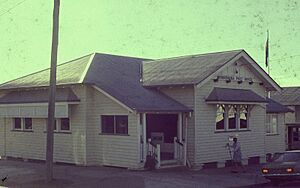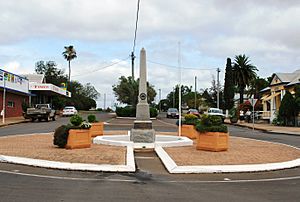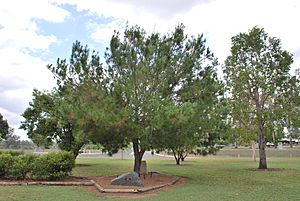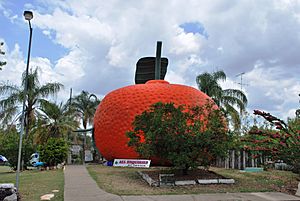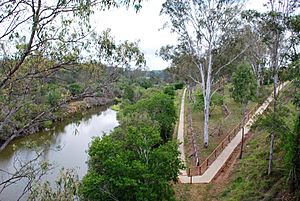Mundubbera facts for kids
Quick facts for kids MundubberaQueensland |
|||||||||||||||
|---|---|---|---|---|---|---|---|---|---|---|---|---|---|---|---|

Lyons St in Mundubbera
|
|||||||||||||||
| Population | 1,120 (2021 census) | ||||||||||||||
| • Density | 31.37/km2 (81.2/sq mi) | ||||||||||||||
| Postcode(s) | 4626 | ||||||||||||||
| Area | 35.7 km2 (13.8 sq mi) | ||||||||||||||
| Time zone | AEST (UTC+10:00) | ||||||||||||||
| Location | |||||||||||||||
| LGA(s) | North Burnett Region | ||||||||||||||
| State electorate(s) | Callide | ||||||||||||||
| Federal Division(s) | Flynn | ||||||||||||||
|
|||||||||||||||
Mundubbera is a small town in the North Burnett Region of Queensland, Australia. It is a rural area. In 2021, about 1,120 people lived here.
Mundubbera is known as the "Citrus Capital of Queensland." This is because many citrus fruits are grown here. However, a nearby town called Gayndah also claims this title!
Contents
Exploring Mundubbera's Location
Mundubbera is in the Wide Bay–Burnett area. It is about 363 kilometers (226 miles) northwest of Brisbane, the state capital. The town is also 209 kilometers (130 miles) north of Dalby and 200 kilometers (124 miles) west of Bundaberg.
The town sits right on the bank of the Burnett River. The area around Mundubbera has different types of land. To the east, there is the Binjour Plateau. The Burnett River forms the southern and western borders. Long ago, people found fossil corals in limestone near Riverleigh. A scientist named Dorothy Hill from the University of Queensland studied these fossils.
A Look Back at Mundubbera's Past
The land around Mundubbera has a rich history. The Gureng Gureng people and the Wakka Wakka people are the traditional owners of this land. They have lived here for thousands of years. The Wakka Wakka language area includes towns like Mundubbera, Cherbourg, and Gayndah.
The name "Mundubbera" comes from an Aboriginal word. It might mean "sharp ridges" or "climbing steps cut in a tree." Another idea is that it means "meeting place of the waters." This would refer to where the Burnett, Auburn, and Boyne rivers meet nearby.
European settlers arrived in the late 1840s. A town area was officially set up in 1861. More people, including migrants from Germany, Britain, and the Netherlands, moved here in the early 1900s. The town grew into what it is today before World War I.
The Mundubbera Post Office opened in 1912. Mundubbera State School started in 1913. In 1963, the school added secondary education for older students. In 2022, it became Mundubbera State College. A railway line reached the town in 1914, helping it grow.
The Mundubbera War Memorial was built to remember those who served in World War I. It was officially opened in 1928.
In 1933, Henry Zipf planted the first citrus orchards. This made Mundubbera a big producer of citrus fruits for export.
The Mundubbera Vietnam Veterans Memorial remembers those who served in the Vietnam War. It is next to the RSL Memorial Hall.
In 1995, a special Lone Pine tree was planted. This tree came from a seedling linked to the famous Gallipoli battle. It is a symbol of remembrance.
Mundubbera's Economy and Jobs
Mundubbera's economy mostly relies on farming and forestry. A lot of cattle are raised here. In areas where water is available for farming, people grow many fruits. These include citrus fruits, mangoes, avocados, and stone fruit like peaches. Mundubbera is also Queensland's biggest producer of table grapes.
During fruit picking seasons, the town gets much busier. Many workers and backpackers from around the world come to find jobs on the farms. They stay in caravan parks or on-site at the farms. Workers from Tonga and Papua New Guinea also come to help with the harvest.
Businesses that support the fruit industry include a fruit juice factory and several packing sheds. There's even a special business called Bugs for Bugs. They raise insects that help control pests on fruit trees, reducing the need for chemical sprays.
Mundubbera also has a timber industry because of the large State forests nearby. There is a timber mill in town. Other industries include pig farming and dairying. The town has local shops, two hotels, two motels, a supermarket, and other services like a butcher, baker, and post office. There is also a public library.
Getting Around Mundubbera
Mundubbera is about 1 kilometer (0.6 miles) south of where the Burnett Highway meets the Mundubbera–Durong Road. The Burnett Highway connects Mundubbera to other towns like Gayndah and Eidsvold. The Mundubbera-Durong Road goes south towards Dalby and Toowoomba.
Public transport is limited. In 2022, a bus service ran three times a week to Bundaberg and once a week to Maryborough.
Schools and Learning in Mundubbera
Mundubbera State College is a school for students from Early Childhood (Prep) up to Year 10. It is located on Bunce Street. In 2017, the school had 242 students. It also has a special education program.
For students who want to go to Year 11 and 12, the closest school is Burnett State College in Gayndah, about 45 kilometers (28 miles) away. Students can also choose distance education or boarding schools.
There are also smaller primary schools in the surrounding rural areas, like Boynewood State School and Binjour Plateau State School.
Places to Visit and Things to Do
The North Burnett Regional Council runs a public library and a public swimming pool in Mundubbera. The Queensland Country Women's Association (QCWA) also has a branch here.
The Apex Ski area, near Jones Weir, is a popular spot for fun. You can go boating, fishing, and water skiing on the weir. There are also barbecue areas and public toilets. It's a great place for bird watching and you might even spot Platypus or Lungfish.
Mundubbera has some interesting attractions:
- The nearby Auburn River National Park is a beautiful place. It is home to the rare Queensland Lungfish, a living fossil found only in the Burnett and Mary Rivers. The park is great for bushwalking and rock climbing. It has waterfalls, swimming spots, and caves.
- A "Black Stump" is located at the town lookout. It symbolizes that Mundubbera is on the edge of the Outback.
- The Big Mandarin is a giant fibreglass model of a mandarin fruit. It is one of Australia's many "Big Things" tourist attractions.
- The "Meeting Place of the Waters" is a 360-degree mural. It shows the Boyne, Auburn, and Burnett Rivers that are important to Mundubbera.
- The Riverside Walk, Bicentennial Park, and Railway Precinct are next to the Jones Weir.
- Part of the Boyne Burnett Inland Rail Trail opened in 2022. This trail follows old railway lines and crosses several historic bridges, like the Humphery Bridges. These bridges are recognized as important engineering heritage sites.
Exciting Events in Mundubbera
Mundubbera hosts several fun events throughout the year:
- A popular seven-a-side cricket tournament happens every February.
- The Mundubbera Fish Stocking Association holds a fishing competition.
- The Ellendale Open, a golf tournament, takes place each year on the Queen's Birthday weekend.
- The town's annual agricultural show is held in May. It features a rodeo, cattle and chicken judging, art and food judging, and a fun side show alley.
- The "State of Oranges" Rugby league match is played between Mundubbera and Gayndah. It's a friendly rivalry between the two towns.
- The Mundubbera Bullarama committee organizes an annual Rodeo in September. It attracts bull riders from all over Queensland.
- Mundubbera has a motocross track that hosts several races each year.
Famous People from Mundubbera
Some well-known people have come from Mundubbera:
- Kurt Brown is a champion lawn bowls player from Queensland and Australia.
- Wayne Goss was born in Mundubbera and later became the Premier of Queensland.
- Martin Love is an Australian test cricketer who was born and grew up in Mundubbera.
- Kim McCosker, a famous author and cook, was raised in Mundubbera.
- Stuart Tinney is an Olympic gold medalist in equestrian riding. He was born in Mundubbera.
See also
 In Spanish: Mundubbera para niños
In Spanish: Mundubbera para niños



